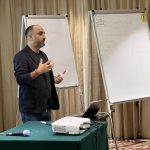It seems we are all singing and dancing about AI with gay bloody abandon. But did you know this basic theory is not new.
In 1932, a great gent, the American Vice President of J Walter Thompson, James Webb Young, advanced a simple theory of how we could use information to be cleverer little souls. He spelt it out in deceptively simple terms in a great, slender book called ‘A Technique for Producing Ideas’.

He broke the process into five principles. But for today, for brevity and relevance to AI, I will just tell you about the first two.
But before I begin there’s something important you need to know. In a 2010 article in Scientific American, and I quote, ‘the memory capacity of the human brain was reported to have the equivalent of 2.5 petabytes of memory capacity. As a number, a “petabyte” means 1024 terabytes or a million gigabytes, so the average adult human brain has the ability to store the equivalent of 2.5 million gigabytes digital memory’.
FYI, they say memory is better among folks in their twenties. (Sod! Ed). But it is not necessarily true that the older you get the less creative you get. Einstein was in his 70’s when he first said E=MC2. (Whew! Ed).
In contrast, again I quote, ‘Chatbots are trained on a corpus of text data of around only 570GB of datasets, including web pages, books, and other sources’. So sorry to say, the human bonce seems to still have five times the capacity of any AI.
With that in mind here’s how Young broke down his technique over 90 years ago, sitting in a smart office in a groovy double breasted suit.Without a laptop.
One: Gather the facts.
Young suggested that the creative oik should spend as much time absorbing info as possible, much like feeding stuff into the chat sites. Specific facts relating to the project and audience. Familiarize yourself with the product or project: generally absorb, study, read, input all and everything you can.
Two: An idea rests upon the ability to see relationships.
Know what a kaleidoscope is? A tube full of thousands of little bits of coloured glass. Look through one end, twist it and voila, a beautiful pattern. Twist again and a new and unique pattern is formed. And again, and again, and again. The number of relationships forming new patterns is enormous if not limitless.

So if the kaleidoscope is your noggin, and the pieces of glass are the facts: the information, trivia, the data gathered, you have the perfect equivalent of ChatGPT. But with potentially four+ times the capacity.
But there are two drawbacks.
You have to practice.
A technique for producing ideas is a discipline that needs practice, maybe years of practice.
The word discipline is well chosen, because if you try to short-circuit the process, if you don’t train yourself to collect the information, if you think you’re too smart to digest the information; if you think you’re too inspired to turn the information over in your mind, or if you are just plain lazy, then you’re badly mistaken. You have to work on it.
In present day terms AI could just be an easy way out. You don’t have to do the hard work; you can just ask the Chatbot to do it for you. But remember it still doesn’t have what your mind has in terms of bytes. Or distinctiveness.

Young said mental training is not unlike physical training. Stop practicing and you’ll get fat and flabby!
The next piece of bad news is that not everyone is equipped to use Young’s technique. Not everyone can or want to use the info they have absorbed. (Oh! Bugger. Ed).
As far back as the 19th Century, the Italian sociologist, Vilfredo Pareto, separated people into two types.
The first type is the speculator. Those that are best able to have ideas.
People who question everything and are always looking for the new way of doing things. A rebel with the burning need to change, improve; someone who doesn’t think in terms of success but takes risks, relies on instinct and imagination; damn the torpedoes.
The very definition of thinking outside of the box.
The second Pareto person is the conservationist. Those that are not really interested in change.
The person who is a steady-going organizer; likes systems and rules and checklists. Don’t fix it if it ain’t broke. Uphold the status quo. Prefers a neat and efficient world. Success is based on conformity and the line of least resistance.
The very definition of the bean counter.
So there you are. Decades ago, in a time without computers, the idea of the human brain being the best generative pre-trained transformer available was first suggested and, according to the Scientific American, it’s still true. But for how long, who knows?
To leave you, with an updated word of wisdom, also from JWT.
AI is simply a tool – like a hammer. With it you can successfully knock in a nail or painfully smash yourself on the thumb. So have a care.
Ouch!
Paul J Loosley is an English person who has been in Asia 40 years, 12 as executive creative director and regional planner for JWT and 26 making TVCs. Retired some five years ago yet still, for some strange reason, he can’t shut- up about advertising. Any feedback: mail p.loosley@gmail.com (please keep it chatty).
MARKETING Magazine is not responsible for the content of external sites.











